Austin is an all-around cool place. There’s always plenty of music and events happening with some of the hippest people around. The housing is insanely expensive, but that’s nothing new. Other than human places of fun and adventure, Austin is also home to plenty of wildlife, including spiders. Let’s take a moment to spotlight those arachnids who call Austin home and see what exactly can be found crawling around the fine city.
1. Brown Recluse Spider (Loxosceles Reclusa)
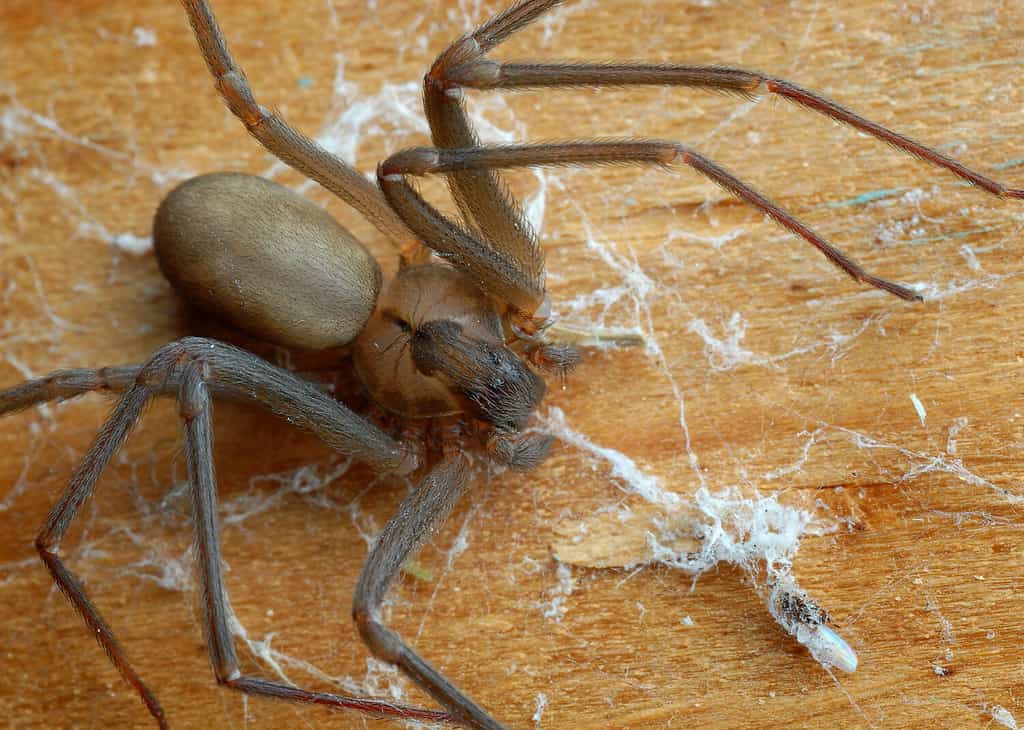
Brown recluse spiders have a clean violin shape on the front part of their body.
©Miles Boyer/Shutterstock.com
Appearance: Light brown body with a distinct fiddle starting at the head. They have dark brown legs and lack much hair. They also only have six eyes.
Size: Their bodies are smaller than half an inch, but their legspan is quarter to half dollar-sized.
The infamous brown recluse spider has a really bad reputation that it doesn’t entirely deserve. The spiders are known for their necrotizing bite, which something does happen, but mostly, it does not. Far more types of spiders and insects can cause a skin-decaying bite than just the ol’ brown recluse.
The brown recluse’s lack of desire to be around anyone, especially humans, is loud and clear right in their name. The only time any spider will attack is when they are faced with dying as the other option. Very few, if any, creatures willingly want to die, and the brown recluse is not one of the ones eagerly walking the plank.
Commonly, these arachnids can get caught in your sheets while tossing and turning all night. Once they find themselves in a bad position, they will bite. They also sometimes hide in gloves, shoes, or boxes, none of which end well for the spiders. Some of the symptoms of a brown recluse bite can include nausea, vomiting, sweating, dizziness, heart palpitations, redness and itching at the bite site, skin rash the speads all over the body, muscle cramping, and pain, headache and fever and deep blue or purple area around the bite that can also have paleness at the center and look like a bull’s eye. Over time, the blister-like center can take on the form of a blister and then create a hole that ranges in size and creates a necrotizing area. It can take eight hours before the first symptoms show up.
2. Black Widow Spider (Latrodectus)
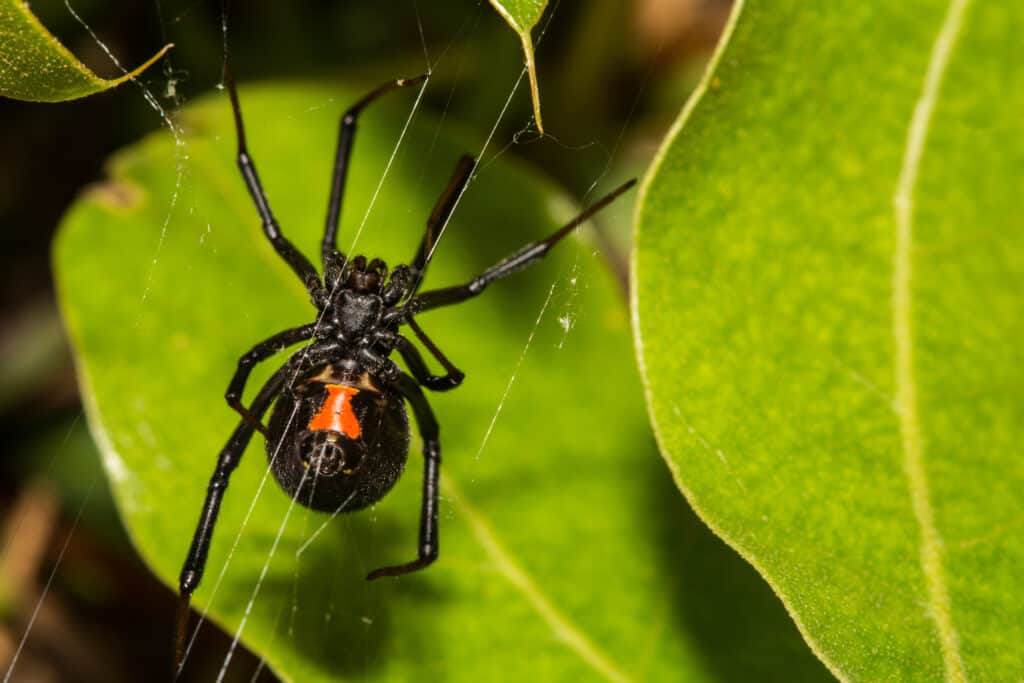
There are several species of black widows in Austin, TX.
©Jay Ondreicka/Shutterstock.com
Appearance: They have a black, glossy body that is round and pea-shaped. They have long, delicate legs that are also hairless.
Size: Pea-sized body with an approximate leg span of 1 – 1.5 inches
The notorious female black widow spider even has a superhero or antihero named after her. These spiders have an ever worse reputation than the brown recluse, but only slightly. They both have neurotoxin venom that can be released when they bite. This venom is not for humans or mammals or anything bigger than an insect. The venom is specifically there to keep them from starving to death by acting as a paralyzing agent for insects. Once they paralyze the insect, they eat it.
A bite from a black widow is painful, but they don’t always bite and release venom. Sometimes, probably specifically with humans, they don’t use venom. If they choose to use venom and bite a child, an elderly person, or someone with an immune disorder or sensitivities to venom, the person could find themselves in real trouble.
Generally, black widow bites are not fatal but can include the following symptoms: muscle cramping, nausea, dizziness, abdominal pain, vomiting, headache, high blood pressure, facial swelling, seizures, sweating, and anxiety. Children can die from the bite. Everyone who has been bitten should collect the spider in a jar if possible and go immediately to the ER. Antivenom is available if needed.
3. Texas Tan Tarantula (Aphonopelma anax)
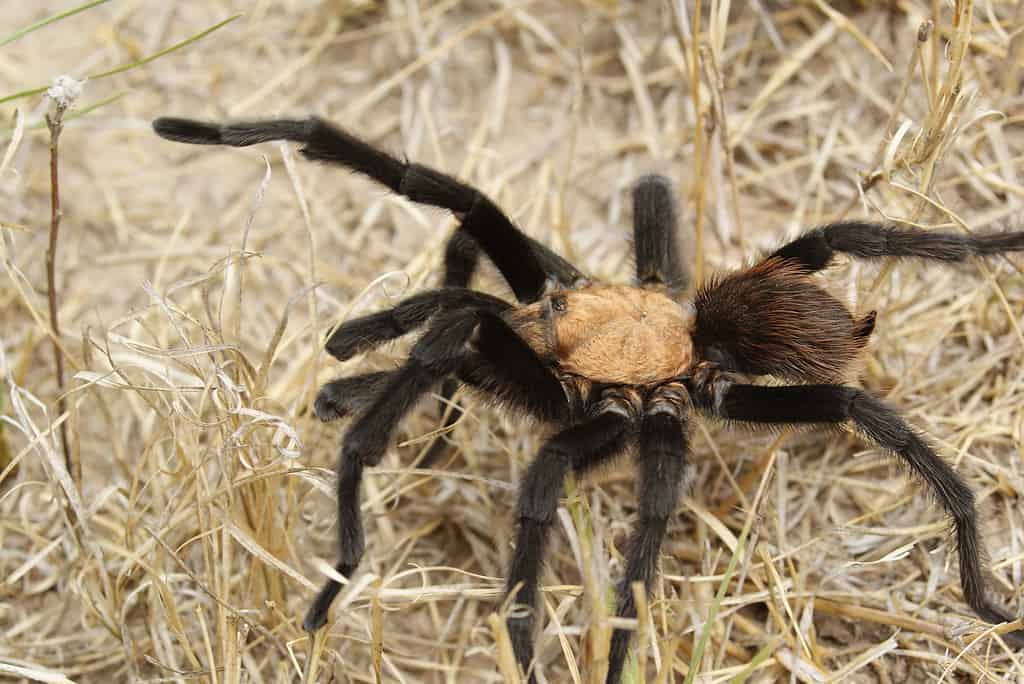
Texas Tan Tarantula (Aphonopelmas anax) is one of the most docile types of tarantula.
©Dallas Krentzel / CC BY 2.0 – License
Appearance: Tan or brown body with dark brown or black legs. They are called different things in different places, but the scientific name does not change.
Size: 1 – 2 inches long with up to 6-inch leg span, which is on the larger end for a tarantula.
Tarantulas are certainly another heavily feared arachnid that doesn’t deserve the bad reputation. They are larger than the usual spider, and their “fangs” look a bit worse than most, but they are pretty harmless. The Texas tan tarantula isn’t known for its ferocity or deadly bite. They are known to be one of the tarantulas that have been labeled “beginner tarantulas” in the industry. But don’t misunderstand; they are not fans of surprise greetings or surprises in general.
If you do happen to surprise one, it will kick urticating hairs on its back legs, which can cause an allergic reaction in some people. The barbed hairs generally cause itching wherever they get under your skin. If you happen to get bitten, which is unlikely because they would much rather run first, it will probably hurt and nothing more. The only people who could react to the venom are those who are allergic to venoms in general.
4. Sun Spider, Wind Scorpion or Camel Spider (Solifugae)
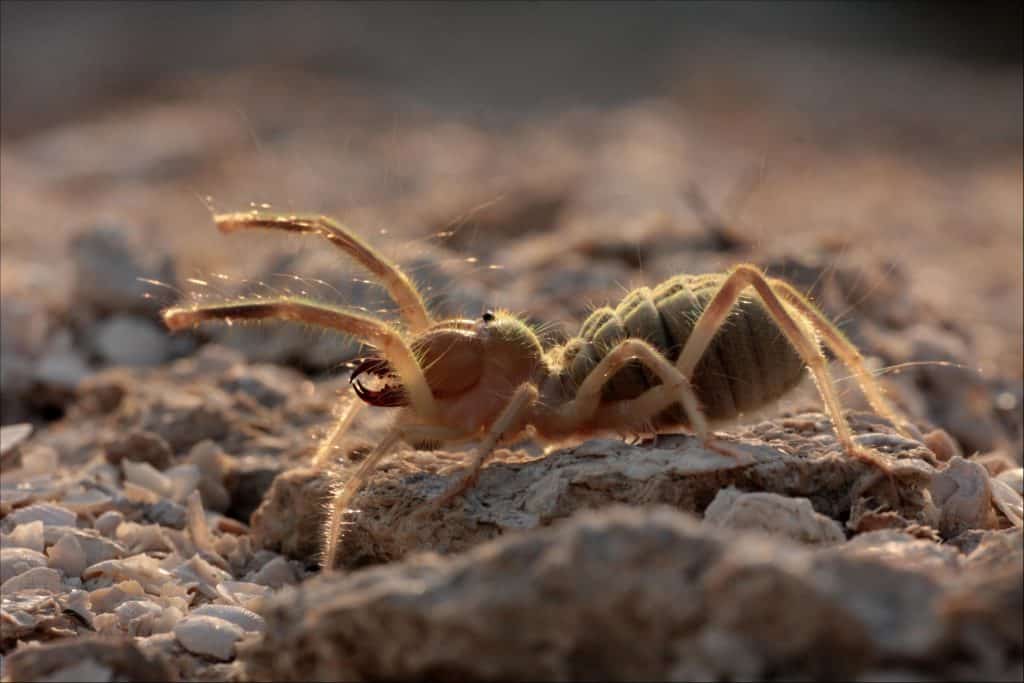
They look like a desert alien but are somewhere in between scorpions and spiders.
©Dmitry Fch/Shutterstock.com
Appearance: Tannish yellow color with strange scorpion-like pinchers for their
Size: 5 – 6 inches long
These bizarre-looking creatures are from this planet, which may come as a surprise. To make matters a little more uncomfortable, they are called wind scorpions because they are fast like the wind. They can run an impressive 10 mph! These arachnids have eight legs like the others, plus two bonus leg-like appendages that help navigate the world of prey and tell the sun spider what exactly it is touching.
The sun spider is not someone you want to get bit by. Their duel chelicerae or pincher-type appendages will deal a nasty bite to whoever chooses to threaten them. Their bite can kill some dogs, supposedly, but not humans. The person bitten will experience pain, maybe bleed a bit, and possibly feel slightly nervous around the sandy ground since these creatures blend in very well, especially if that person isn’t fast on their feet. Other than that, sun spiders are not at all harmful to humans and do not have any venom at all. They just look strange, but in all fairness, so do humans.
5. Humpbacked Orbweaver (Eustala anastera)
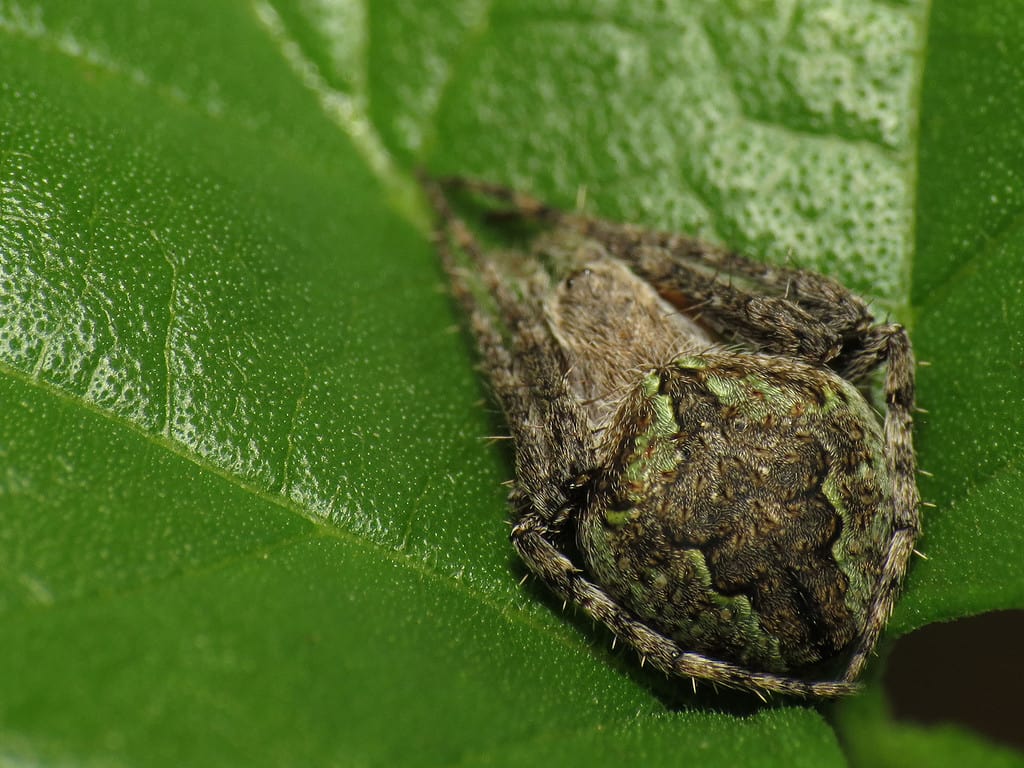
Humpbacked Orbweaver (Eustala anastera)
©Katja Schulz from Washington / D. C., USA, CC BY 2.0 – License
Appearance: These extra cool spiders have a body that is a bit longer than it is wide and tends to come in shades of brown, and have a dark brown intricate design on their humped backs. This is not always the case, and some may be white, green, or reddish brown. The patterns can differ. Their abdomen is triangular shaped, and their legs are banded. Sometimes, the abdomen has a vertical stripe down it, as well.
Size: The orb weavers are not very large, with a body size of 10 millimeters when mature. The males are only slightly smaller at 9.5 millimeters. Commonly, male spiders are much smaller than females.
Orbweavers are some of the most common and probably the most artistic of any family of spiders. They all make intricate orb-shaped webs to catch small insects that happen to be flying by. Most orb weavers are nocturnal, and the humpbacked orb weaver is no different. She spends her evening catching bugs and lying in wait. When morning draws near, the humpbacked orb weaver tears down her web, eating it and sleeping for the day. When evening draws near, she once again builds her quickly created intricate web and waits for the sun to set.
These small, delicate orb weavers do not sit in their webs or even in a hidden hammock. Instead, they blend in perfectly with bark from the tree or branch they have selected to use to hold their webs. They sit with their legs drawn in near their bodies, which is different from most spiders. This way, they can blend in better with the branch. It is also how they defend themselves against predators. They simply fold their legs. They will sit on a nearby branch and wait for a passing insect to make the mistake of coming their way. Their web sits between branches on the outside of forest clearings, or anywhere insects may fly through unsuspecting in the night.
6. Striped Bark Scorpion (Centruroides vittatus)

The striped bark
scorpion
is not a true spider, though it is in the arachnid family, along with spiders.
©IrinaK/Shutterstock.com
Appearance: The younger scorpions are a yellowish color, whereas the adults have more brown on their backs. The adults may also be yellowish to tan and have two black stripes along their backs. Their pedipalps and tails are long and thin. The tail is slightly longer on the males.
Size: Adults can measure up to 3.5 inches long, though average 2.5 inches.
The striped bark scorpion is the most common species of scorpion in the southern US and also the world. They are the most active at night when it is cooler out.
The sting from a striped bark scorpion can cause mild to severe pain and swelling. It can also cause numbness by the sting, muscle pain and convulsions, nausea, and, in rare cases, problems breathing. The sting is not fatal or severe unless you are allergic to the venom.
7. Carolina Wolf Spider (Hogna Carolinensis)

The Carolina
wolf spider
is one of nature’s greatest mothers. This is a photo of one with loads of children riding on her back. They do this to provide the ultimate protection for their kids.
©Chase D’animulls/iStock via Getty Images
Appearance: The spider is a mottled brown color on the upper and a dark brown underneath. The top intricate design is black. Their reddish tan chelicerae are smooth-haired and thick. They have two large forward-facing eyes that give them an endearing look. Four of the eyes are arranged underneath the two large eyes, and the other two are found on either side of the head. They have long legs with some hairs they use to “hear” and pick up vibrations.
Size: 1/2 – 1 inch long body with a 3 – 4 inch leg span. This species of wolf spider is the largest in North America and is highly common, not just in NC, as you can see.
Wolf spiders are the second most intelligent spiders in the world. They, like jumping spiders, are excellent at figuring out what their prey’s next move might be and then chasing them down. The mother wolf spiders carry their egg sac with them wherever they go until it is time for them to hatch. Then she helps them come out by tearing a hole big enough for the slings to exit, where they climb aboard her back. They will stay there for a week or more until they are big and strong enough to make it on their own. That’s a lot of work for any mother!
8. Yellow Garden Spider (Argiope Aurantia)
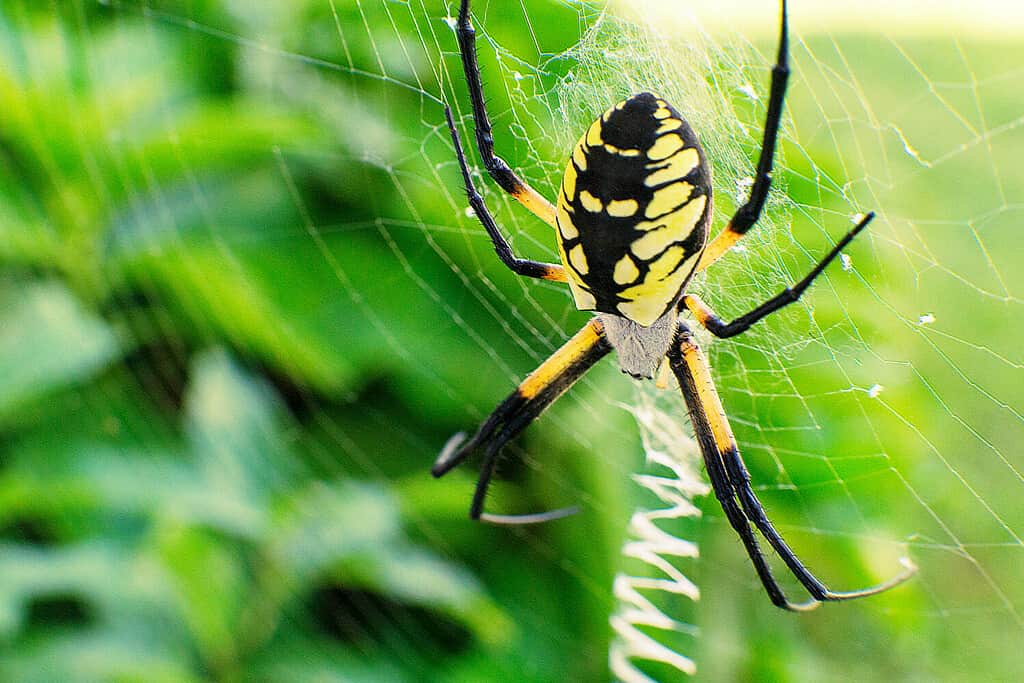
The yellow garden spider is one of the largest spiders in the world and is also one of the most mistakenly feared.
©Theodore P. Webb/Shutterstock.com
Appearance: These are large black spiders with yellow markings and a grey head. Their long, delicate legs are black and yellow banded. They have very tiny and mostly useless eyes with poor vision. The yellow garden spiders are frequently confused with the joro spider in the U.S. The joro spider is longer, thinner, and has red on the underside of its yellow and grey striped abdomen. They do, however, also have greyheads.
Size: Females have bodies that are 1 – 2 inches long and can have a leg span of up to 4 inches.
The yellow garden spider, also sometimes referred to as the writing spider or the zigzag spider, is most active in the late summer when they mate and lay up to three egg sacs. Each egg sac can contain up to 1000 spiderlings who will hatch but remain inside the egg sac until spring when the weather is more suitable for their survival. Using a technique that many spiders use called ballooning, the baby spiders will float away on a strong breeze and start their new lives.
Most garden spiders die at the first frost, but some females can live several years in warm climates. The males do not live long after reaching maturity and are sometimes eaten after mating. The male will strum lightly on the edge of the female’s web to gain her acceptance before making his move.
9. Grass Spider (Agelenopsis)
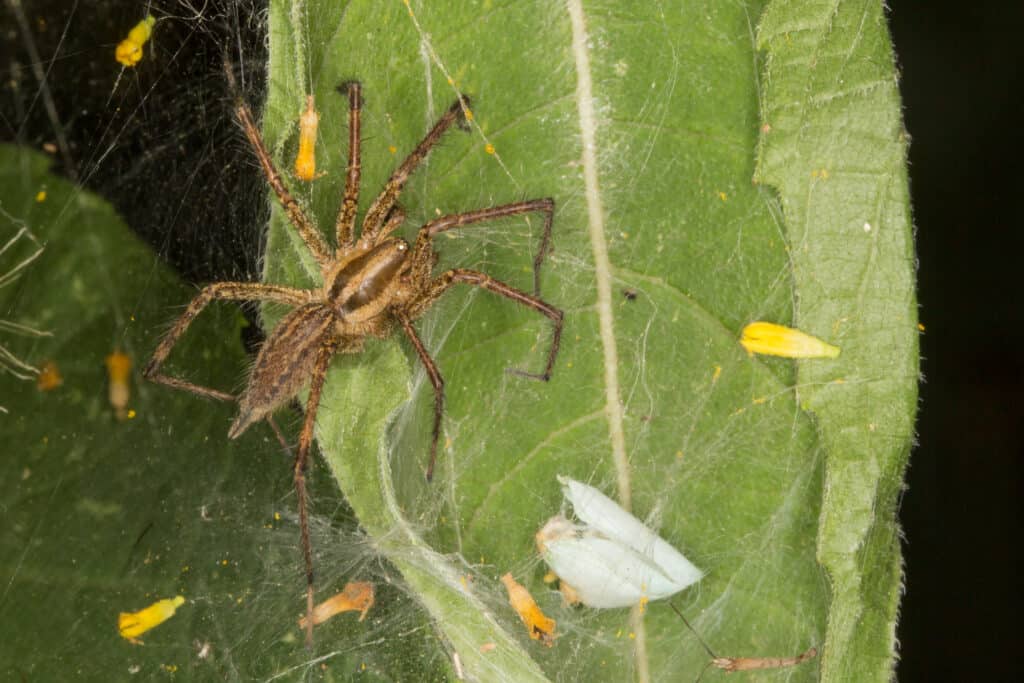
©Elliotte Rusty Harold/Shutterstock.com
Appearance: Grass spiders look similar to rabid wolf spiders and are also very fast. Unlike the rabid wolf spider, the grass spider is a funnel weaver.
Size: The grass spider is a small to medium-sized spider with a maximum body length of 0.50 an inch and a leg span of 1.5 inches.
The small grass spider is a funnel web spider. This means it will stay in the grass, fencing, near backyard lighting, or other areas that commonly see a lot of small insects and create sheet webs. The sheet has a funnel along with it that the spider lives and sleeps in when not lying in wait for insects at night. They can sometimes create sheet upon sheet if the web is in a place where it will not be destroyed by humans or the weather.
These spiders make up a large part of the sparrow and other birds’ diets. They are voracious eaters and are responsible for helping keep the mosquito, gnat, and other small flying insect populations down. They are extremely fast and grab the insect, disappearing back down into their funnel so as not to be seen by a predator.
10. Woodlouse Spider (Dysdera Crocata)

The
woodlouse
spider (Dysdera crocata) is a fiercely protective mother.
©Macronatura.es/Shutterstock.com
Appearance: Reddish, stocky-bodied spider with a light beige, jellybean, or tick-like abdomen. The mouthparts are evident at the front of the body, more so than with many other spiders. Sometimes, the abdomen can be more grey than pinkish beige. The woodlouse spider has a smooth, shiny body with very little hair. They only have six eyes arranged in an oval, whereas most spiders have eight.
Size: The females range from 11 – 15 millimeters long, while the males are slightly smaller in size at 9 – 11 millimeters long.
The small woodlouse spider does not make a web to hunt but makes a small silk-lined bed to sleep in during the day. These nocturnal spiders can be found underneath rocks or other damp places where isopods can be found. The females lay up to 70 eggs at a time and have them suspended by a few strands of silk. Once the babies hatch, they stay with their mothers for a while.
The woodlouse spider has been known to attack centipedes and other spiders. When mating, they even run the risk of injuring each other with their large chelicerae. These are spiders who will bite if you poke at them. They are fierce defenders of their homes and eggs. The bite is painful but not medically significant.
11. Trapdoor Spider (Ctenizidae ummidia)

Trapdoor spiders are distantly related to the tarantula.
©Pichit Sansupa/Shutterstock.com
Appearance: The trapdoor spider looks a bit like a miniature tarantula. It has segmented legs, a round abdomen, and a stout build. Their eyes are grouped close together, with two in the middle and three on either side. They have short, thick legs that are reddish brown to dark brown.
The front section of their bodies, the cephalothorax, is shiny, and their entire bodies are almost hairless. Their chelicerae are forward-facing, meaning they stab downward when striking prey. Most true spiders have chelicerae that move side to side to pinch prey. Also, their chelicerae come equipped with rake-like appendages called rastellum, which help them dig burrows.
Size: They can range from 0.40 – 1.5 inches long.
The trapdoor spider is an interesting spider that digs six-inch deep silk-lined tunnels to spend their days in. The females will spend their entire lives inside the tunnel and can live for a long time. The oldest on record lived to be in its forties! The males leave their tunnels once mature to search for a mate or three. If they can survive the first encounter with a female, they will go on to mate with as many females as possible until their time runs out.
12. Grey Wall Jumping Spider (Menemerus Bivittatus)

Grey wall jumping spiders (Menemerus bivittatus) might be tiny, but they are highly skilled hunters.
©Stu’s Images / CC BY-SA 4.0 – License
Appearance: Small, fur-covered spiders with a fuzzy appearance and two large forward-facing eyes. They also have two eyes on either side of their heads and two that are rear-facing. This eye setup gives the jumping spider 360 degrees of vision, helping to make them amazing tiny hunters. The grey wall jumping spider has banded grey and black or dark brow legs, a grey body with brown highlights, and vertical stripes down its abdomen and across its eyes. They look as if they are masked.
Size: The female grey wall jumper is 8 – 10 millimeters long, while the male is 8 – 9 millimeters.
These tiny jumping spiders are capable of jumping longer than 10 times their body length and can catch insects in mid-flight. They do not make webs to catch prey but instead hunt for their prey in a nomadic sense, chasing them down on foot. The males may roam for their lives, while the females tend to make a small hammock that they sleep in nightly.
Since they are diurnal spiders, the light helps them see their prey more clearly. They are excellent at catching small flying insects, beetles, small worms, crickets, grasshoppers, and others.
13. Long-Bodied Cellar Spider (Pholcus phalangioides)

The long-bodied cellar spider (Pholcus phalangioides) is commonly and mistakenly called a daddy long legs.
©Marek Velechovsky/Shutterstock.com
Appearance: They have a small, long, thin body with very long, thin legs. They are often confused with the harvestman, which is also called a daddy long legs, but it is not related to the long-bodied cellar spider. They are grey or beige colored and
Size: Their body is 7 – 8 millimeters long with legs that have a 1 – 2 inch leg span.
These long-legged spiders are very wispy in appearance and sometimes bounce violently in their webs when disturbed. This is done to make them become a blur and mostly invisible to predators. They make messy-looking cobwebs in corners of rooms, basements, and outdoors where they can be out of the rain. They prefer moist habitats that go undisturbed. The long-bodied cellar spiders are very common throughout the U.S.
The photo featured at the top of this post is © Dr.MYM/Shutterstock.com
Thank you for reading! Have some feedback for us? Contact the AZ Animals editorial team.







